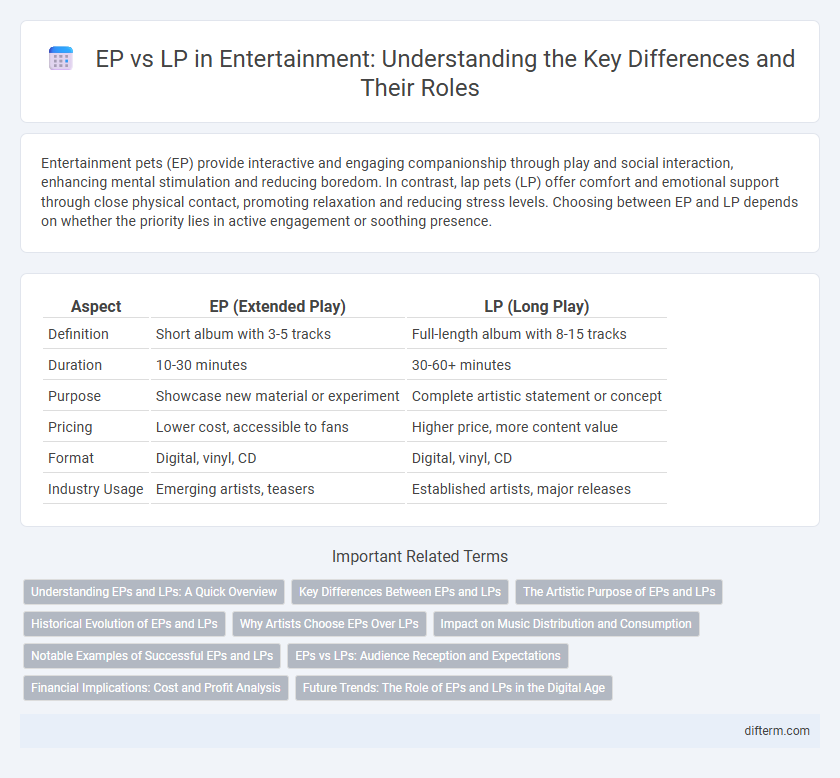Entertainment pets (EP) provide interactive and engaging companionship through play and social interaction, enhancing mental stimulation and reducing boredom. In contrast, lap pets (LP) offer comfort and emotional support through close physical contact, promoting relaxation and reducing stress levels. Choosing between EP and LP depends on whether the priority lies in active engagement or soothing presence.
Table of Comparison
| Aspect | EP (Extended Play) | LP (Long Play) |
|---|---|---|
| Definition | Short album with 3-5 tracks | Full-length album with 8-15 tracks |
| Duration | 10-30 minutes | 30-60+ minutes |
| Purpose | Showcase new material or experiment | Complete artistic statement or concept |
| Pricing | Lower cost, accessible to fans | Higher price, more content value |
| Format | Digital, vinyl, CD | Digital, vinyl, CD |
| Industry Usage | Emerging artists, teasers | Established artists, major releases |
Understanding EPs and LPs: A Quick Overview
EPs (Extended Plays) typically contain 3 to 5 tracks and run for about 15 to 30 minutes, serving as a showcase of an artist's work without the commitment of a full album. LPs (Long Plays) generally feature 8 to 12 tracks with a duration of 30 to 60 minutes, offering a more comprehensive listening experience that often reflects a cohesive theme or concept. Both formats play distinct roles in music distribution, with EPs often used to introduce new material or experiment creatively, while LPs establish a more complete artistic statement.
Key Differences Between EPs and LPs
EPs (Extended Plays) typically feature 3 to 5 tracks with a total duration under 30 minutes, offering a concise showcase of an artist's work. LPs (Long Plays), also known as full-length albums, usually contain 8 to 12 tracks or more, running over 30 minutes and providing a comprehensive listening experience. The distinction influences marketing strategies, streaming categorization, and production costs within the music industry.
The Artistic Purpose of EPs and LPs
EPs (Extended Plays) serve as a concise artistic expression, allowing musicians to explore new styles or themes without the commitment of a full album, often bridging gaps between LP releases. LPs (Long Plays) provide a comprehensive narrative or thematic journey, showcasing an artist's depth and versatility through a fuller, more immersive listening experience. The artistic purpose of EPs lies in experimentation and immediacy, while LPs emphasize cohesion and storytelling in entertainment.
Historical Evolution of EPs and LPs
EPs (Extended Plays) emerged in the early 1950s as a middle-ground format offering more tracks than singles but fewer than LPs (Long Plays), catering to consumer demand for affordable music collections. LPs, introduced by Columbia Records in 1948, revolutionized the music industry by enabling artists to present full albums with improved sound quality on 12-inch vinyl records. The evolution of EPs and LPs reflects technological advancements and changing consumption patterns, influencing how music was marketed and experienced throughout the 20th century.
Why Artists Choose EPs Over LPs
Artists often choose EPs over LPs due to shorter production times and lower costs, allowing for faster release cycles and more consistent audience engagement. EPs provide flexibility to experiment with new sounds or concepts without the commitment of a full album, facilitating creative exploration and market testing. This strategy helps maintain relevance and momentum in the fast-paced entertainment industry where consumer attention spans are limited.
Impact on Music Distribution and Consumption
EPs (Extended Plays) revolutionized music distribution by offering artists a versatile format between singles and albums, enabling quicker releases and sustained audience engagement. LPs (Long Plays) traditionally serve as comprehensive collections that showcase an artist's full creative range, often influencing album-oriented listening habits and physical sales. The rise of digital platforms has shifted consumption patterns, with EPs facilitating rapid content delivery and LPs maintaining their role in defining artistic identity and in-depth storytelling.
Notable Examples of Successful EPs and LPs
Notable successful EPs include Billie Eilish's "Don't Smile at Me," which propelled her into global fame, and The Weeknd's "My Dear Melancholy," showcasing a shift to darker, atmospheric R&B. Iconic LPs such as Michael Jackson's "Thriller" and Taylor Swift's "1989" broke sales records and influenced pop culture profoundly. These releases underscore the strategic use of EPs for emerging artists and LPs for full-length, impactful storytelling in entertainment.
EPs vs LPs: Audience Reception and Expectations
EPs typically offer a concise, focused listening experience that appeals to fans seeking new material without the commitment of a full album, often generating excitement with exclusive or experimental tracks. LPs provide a more immersive journey, attracting audiences who value cohesive storytelling and a deeper artistic statement, often reflected in higher sales and streaming numbers. Audience expectations for EPs lean towards variety and exploration, while LPs are anticipated as definitive works showcasing an artist's range and maturity.
Financial Implications: Cost and Profit Analysis
EPs (Extended Plays) typically involve lower production costs than LPs (Long Plays) due to fewer tracks and shorter studio time, resulting in reduced upfront investment. Although LPs generate higher revenue per unit because of their length and perceived value, the break-even point often requires selling significantly more copies to cover the larger initial expenses. Profit margins fluctuate based on marketing budgets and distribution channels, with EPs offering quicker returns on investment, while LPs have the potential for greater long-term earnings.
Future Trends: The Role of EPs and LPs in the Digital Age
EPs and LPs continue to evolve as streaming services shape music consumption, with EPs offering artists a flexible format for frequent releases and audience engagement. LPs maintain their status as comprehensive artistic statements, appealing to dedicated listeners who value immersive storytelling through extended playtime. Emerging trends indicate a hybrid approach where digital platforms optimize both formats for tailored listener experiences and monetization opportunities.
EP vs LP Infographic

 difterm.com
difterm.com